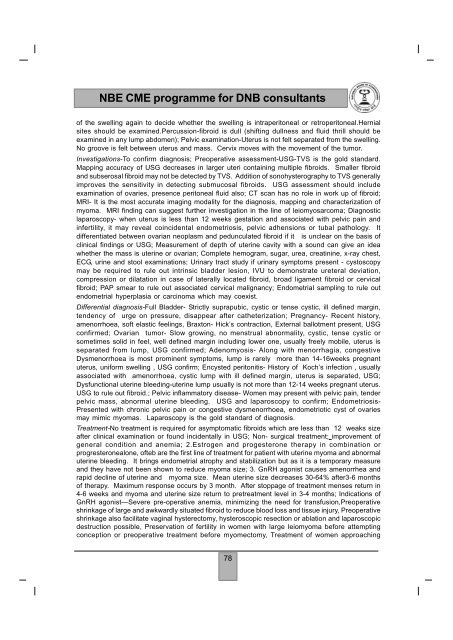NBE CME programme for DNB consultants - National Board Of ...
NBE CME programme for DNB consultants - National Board Of ...
NBE CME programme for DNB consultants - National Board Of ...
You also want an ePaper? Increase the reach of your titles
YUMPU automatically turns print PDFs into web optimized ePapers that Google loves.
<strong>NBE</strong> <strong>CME</strong> <strong>programme</strong> <strong>for</strong> <strong>DNB</strong> <strong>consultants</strong>of the swelling again to decide whether the swelling is intraperitoneal or retroperitoneal.Hernialsites should be examined.Percussion-fibroid is dull (shifting dullness and fluid thrill should beexamined in any lump abdomen); Pelvic examination-Uterus is not felt separated from the swelling.No groove is felt between uterus and mass. Cervix moves with the movement of the tumor.Investigations-To confirm diagnosis; Preoperative assessment-USG-TVS is the gold standard.Mapping accuracy of USG decreases in larger uteri containing multiple fibroids. Smaller fibroidand subserosal fibroid may not be detected by TVS. Addition of sonohysterography to TVS generallyimproves the sensitivity in detecting submucosal fibroids. USG assessment should includeexamination of ovaries, presence peritoneal fluid also; CT scan has no role in work up of fibroid;MRI- It is the most accurate imaging modality <strong>for</strong> the diagnosis, mapping and characterization ofmyoma. MRI finding can suggest further investigation in the line of leiomyosarcoma; Diagnosticlaparoscopy- when uterus is less than 12 weeks gestation and associated with pelvic pain andinfertility, it may reveal coincidental endometriosis, pelvic adhensions or tubal pathology. Itdifferentiated between ovarian neoplasm and pedunculated fibroid if it is unclear on the basis ofclinical findings or USG; Measurement of depth of uterine cavity with a sound can give an ideawhether the mass is uterine or ovarian; Complete hemogram, sugar, urea, creatinine, x-ray chest,ECG, urine and stool examinations; Urinary tract study if urinary symptoms present - cystoscopymay be required to rule out intrinsic bladder lesion, IVU to demonstrate ureteral deviation,compression or dilatation in case of laterally located fibroid, broad ligament fibroid or cervicalfibroid; PAP smear to rule out associated cervical malignancy; Endometrial sampling to rule outendometrial hyperplasia or carcinoma which may coexist.Differential diagnosis-Full Bladder- Strictly suprapubic, cystic or tense cystic, ill defined margin,tendency of urge on pressure, disappear after catheterization; Pregnancy- Recent history,amenorrhoea, soft elastic feelings, Braxton- Hick’s contraction, External ballotment present, USGconfirmed; Ovarian tumor- Slow growing, no menstrual abnormality, cystic, tense cystic orsometimes solid in feel, well defined margin including lower one, usually freely mobile, uterus isseparated from lump, USG confirmed; Adenomyosis- Along with menorrhagia, congestiveDysmenorrhoea is most prominent symptoms, lump is rarely more than 14-16weeks pregnantuterus, uni<strong>for</strong>m swelling , USG confirm; Encysted peritonitis- History of Koch’s infection , usuallyassociated with amenorrhoea, cystic lump with ill defined margin, uterus is separated, USG;Dysfunctional uterine bleeding-uterine lump usually is not more than 12-14 weeks pregnant uterus.USG to rule out fibroid.; Pelvic inflammatory disease- Women may present with pelvic pain, tenderpelvic mass, abnormal uterine bleeding. USG and laparoscopy to confirm; Endometriosis-Presented with chronic pelvic pain or congestive dysmenorrhoea, endometriotic cyst of ovariesmay mimic myomas. Laparoscopy is the gold standard of diagnosis.Treatment-No treatment is required <strong>for</strong> asymptomatic fibroids which are less than 12 weaks sizeafter clinical examination or found incidentally in USG; Non- surgical treatment; improvement ofgeneral condition and anemia; 2.Estrogen and progesterone therapy in combination orprogresteronealone, ofteb are the first line of treatment <strong>for</strong> patient with uterine myoma and abnormaluterine bleeding. It brings endometrial atrophy and stabilization but as it is a temporary measureand they have not been shown to reduce myoma size; 3. GnRH agonist causes amenorrhea andrapid decline of uterine and myoma size. Mean uterine size decreases 30-64% after3-6 monthsof therapy. Maximum response occurs by 3 month. After stoppage of treatment menses return in4-6 weeks and myoma and uterine size return to pretreatment level in 3-4 months; Indications ofGnRH agonist—Severe pre-operative anemia, minimizing the need <strong>for</strong> transfusion,Preoperativeshrinkage of large and awkwardly situated fibroid to reduce blood loss and tissue injury, Preoperativeshrinkage also facilitate vaginal hysterectomy, hysteroscopic resection or ablation and laparoscopicdestruction possible, Preservation of fertility in women with large leiomyoma be<strong>for</strong>e attemptingconception or preoperative treatment be<strong>for</strong>e myomectomy, Treatment of women approaching78
















